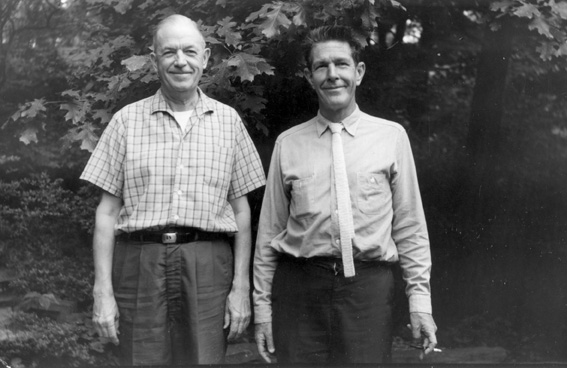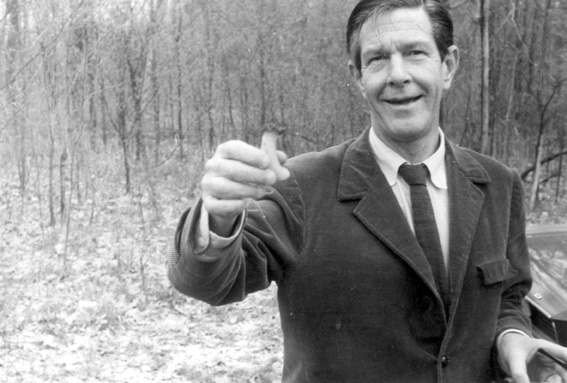By Lauren Fink
A new collection, documenting the friendship between composer John Cage and UC professor Van Meter Ames, has just been added to the Van Meter Ames Papers in the University of Cincinnati Archives and Rare Books Library. Van Meter Ames was a faculty member in the UC philosophy department, beginning in 1925, and served as its head from 1959 until 1966 when he retired. Ames was a Rockefeller grantee, a fellow of the UC graduate school, and a Fulbright research professor in philosophy, University of Komozawa, Tokyo, 1958-59. Throughout his career, Ames wrote and published on a vast range of topics including aesthetics, the self, ethics, religion, science, freedom, existentialism, and Eastern philosophy. His interest in Zen paralleled Cage’s and solidified their mutual respect for one another, which is evidenced in this collection of documents.
John Cage, born in Los Angeles in 1918, became one of the most notable avant-garde composers of the 20th Century. He studied music with famous composers like Arnold Schoenberg, Henry Cowell, Adolph Weiss, and Richard Buhlig but developed a style that was uniquely his own. Cage believed that any sounds could be music, which led him to compose for not only standard instruments, but also found objects, magnetic tape, amplified cacti, vegetables, water, and even silence. An avid Zen Buddhist, Cage sought to compose without intention and often used chance operations, via the I-Ching, when composing. Cage wrote for multiple genres, including opera and ballet, in addition to various forms of chamber ensemble.
Included in Cage’s chamber works are numerous pieces for percussion ensemble, many of which were written specifically for the Percussion Group Cincinnati, ensemble-in-residence at the University of Cincinnati’s College-Conservatory Music. The ensemble includes Allen Otte, James Culley, and Russell Burge. This group worked directly with Cage and even joined him on tour, premiering and recording many of his pieces.
Though most widely recognized for his musical achievements, Cage had a strong influence in the worlds of dance, art, writing, and philosophy. He was the musical director of the Merce Cunningham Dance Company in New York City, and often performed his music with the company in addition to composing for the dance company.. Evolving from a need for compactness when on tour with the dancers, Cage invented the prepared piano. Placing various objects in between the strings of the piano allowed Cage an endless array of percussive sounds without having to lug around percussion equipment. This technique is still employed by many musicians today.
In the realm of visual art, Cage produced lithographs, plexigrams, etchings, and prints. Like his music, much of his art incorporated chance operations and unconventioinal mediums/materials. His well-known works include, but are certainly not limited to, Not wanting to Say Anything About Marcel (1969), Score Without Parts (1978), and Changes and Disappearances (1979-80).
Cage often talked about the overlap between music, film, and art. Considering that “the essential meaning of silence is the giving up of intention.” Cage compared Robert Raushenberg’s white paintings to Yeonah Paik’s film with no images to his own piece, 4’33”. He became a part of the American underground film scene, working with filmmakers like Stan Brakhage and Stan VanDerBeek. During his term as artist in residence at the University of Cincinnati in the 1966-7 academic year, Cage was part of a Cinema Now discussion series.
More of Cage’s philosophy on art, and life in general, can be found in his writings, which include Silence, M, Empty Words, X, A Year from Monday, and Anarchy. Additionally, Cage’s obsession with mushrooms is evidenced by his co-authoring of The Mushroom Book which includes lithographs of mushrooms and hand-written texts on mushroom hunting, identification, and cooking. In conjunction with all of his other artistic works, Cage’s writings involve chance and unusual textual and formal designs.
John Cage’s close relationship with, and influence on, Van Meter Ames is apparent in this collection. A friend and fan of Cage, Ames drafted a manuscript, involving aspects of both Cage’s life and his own, that never received publication but is available in this collection. In this manuscript that overflows with Zen ideologies, dualism is used as a formal design to switch between the narrator’s life and the composer’s. Correspondence between Cage and Ames, newspaper clippings, and programs of Cage’s accomplishments/works, and creative writings of Cage himself are also present in this collection. John Cage died in 1992.
A finding aid for the Van Meter Ames papers is available through the OhioLINK Finding Aid repository. For more information on these or any other Van Meter Ames material, or for additional information on the Archives & Rare Books Library’s collections and services, please go to: http://www.libraries.uc.edu/libraries/arb/index.html. To learn more about Percussion Group Cincinnati, please see: http://pgcinfo.com/PGC.html . And for more information on John Cage, see his papers at the Olin Library at Wesleyan University in Middletown, Connecticut: http://www.wesleyan.edu/libr/schome/FAs/ca1000-72.html.


